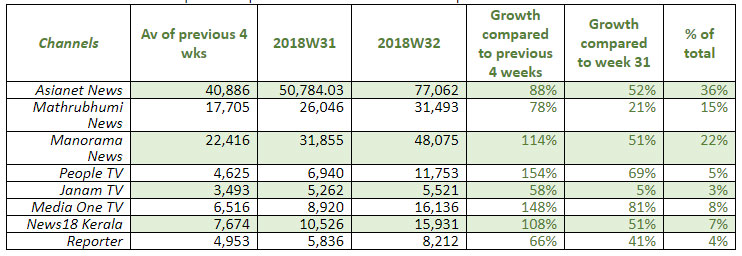MUMBAI: The Kerala cable and broadcast industry is just about keeping its head above the water, quite literally! The industry has been crippled due to the recent floods. We wrote about how cable operators bore the brunt of the calamity yesterday. Needless to say, broadcasters were also not unaffected.
Kerala Vision Digital TV general secretary Rajan KV said that there is no infrastructure loss for TV channels and 500-600 cable networks are still under water. “The viewership has seen 30-35 per cent downfall as many homes were not able to see a single channel both on DTH and cable networks,” he added.
According to BARC data, the incessant rains that derailed Kerala kept viewers hooked to their television sets that were relying on the medium to keep track of the situation. With 214.1 million impressions, week 32 (4-10 August) saw the highest peak for Malayalam news genre in 2018. The genre saw a 98 per cent growth in the week compared to the average of the previous 4 weeks.

In a letter dated 21 August 2018, Cable TV Operators Associations (COA) stated that the cable operators have been the worst affected because of their extensive presence in the flood-affected areas. The affected include human lives and damage to property across the state while power and cable lines have suffered extensive damage and distribution has been totally disrupted.
Mathrubhumi head-distribution Thampi P Joseph said, “Cable TV was the most affected industry by this natural calamity. No monetary losses have been faced by the news broadcasters. In the past two weeks, the GEC rating has gone down and a tremendous growth has been seen for the news channel. We saw a good spike in viewership ever since the floods had started.”
Kerala has a total TV population of close to 31.3 million, out of which, around 25.8 million people watched Malayalam news in week 32. This means that 8 out of 10 people in the state sampled news in this week. Out of the state’s total TV viewership, 17 per cent came from Malayalam news genre alone, with every viewer spending an average of 1 hour 3 minutes watching news.
Manorama director news Johny Lukose also believes that there was no substantial loss for the news channels and no channel in the Kerala market faced any infrastructural damage. “The news channels cancelled all the advertisements from the ad inventory to cover the disaster. Two of our channels, Manorama News and Mazhavil Manorama, have lost Rs 10 crore,” he said.
However, there is still some financial loss that has been felt. According to Insight Media City MD R Sreekandan Nair, the TV broadcasting industry across the state has been set back by more than Rs 50 crore. “We have stopped production of shows for our channels. Apart from the news channel, other players in the market are shifting or repeating the programs. Flower TV has lost almost Rs 10 crore in the disaster. News channels are not affected much because of less tariff, but the entertainment channels have faced huge losses because of the big productions,” Nair said.
Friday (17 August 2018) alone accounted for 34 per cent of the total news viewership for the week at 72.8 million impressions.
Asianet News stood at the top with 36 per cent of total news viewership.

Mathrubhumi News output editor Abi T Abraham said, “By and large, the facilities for the coverage were going as planned. As far as Mathrubhumi is concerned we had about seven Digital Satellite News Gathering vans and 10-15 reporters on the field with live units, except in the case of remote areas where network and electricity were not available. All the channels also did well in terms of covering the disaster but did not face any major damage of technology.”
It will be a challenge to restore conditions in the state and work to make up for the losses that companies have suffered.






